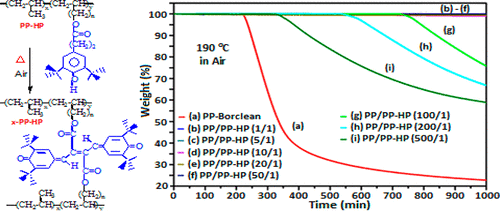当前位置:
X-MOL 学术
›
Macromolecules
›
论文详情
Our official English website, www.x-mol.net, welcomes your
feedback! (Note: you will need to create a separate account there.)
Increasing Polypropylene High Temperature Stability by Blending Polypropylene-Bonded Hindered Phenol Antioxidant
Macromolecules ( IF 5.1 ) Pub Date : 2018-02-22 00:00:00 , DOI: 10.1021/acs.macromol.7b02720 Gang Zhang 1 , Changwoo Nam 1 , Linnea Petersson 2 , Joakim Jämbeck 2 , Henrik Hillborg 2 , T. C. Mike Chung 1
Macromolecules ( IF 5.1 ) Pub Date : 2018-02-22 00:00:00 , DOI: 10.1021/acs.macromol.7b02720 Gang Zhang 1 , Changwoo Nam 1 , Linnea Petersson 2 , Joakim Jämbeck 2 , Henrik Hillborg 2 , T. C. Mike Chung 1
Affiliation

|
Currently, hindered phenol (HP) antioxidants mixed in PP products provide thermal-oxidative protection during PP melt processing (homogeneous mixing). However, there are concerns about their effectiveness during applications. This paper presents computer simulation and experimental results to demonstrate a facile phase separation of HP molecules in the PP matrix and investigates a new approach that can dramatically improve PP thermal-oxidative stability under elevated temperatures. This technology is centered on a new PP–HP copolymer containing a few comonomer units with HP moieties, homogeneously distributed along the polymer chain. Because of the cocrystallization between the PP and PP–HP copolymer, all HP antioxidant groups are homogeneously distributed in the PP matrix (amorphous domains). The resulting PP/PP–HP blends demonstrate a thermal-oxidative stability nearly proportional to the HP content. While commercial PP products (containing regular antioxidants and stabilizers) degrade within a few minutes at 210 °C in air, the PP/PP–HP blend, with the same concentration of HP groups, demonstrates nearly no detectable weight loss after 1000 h. In an ASTM endurance test under a targeted application temperature (140 °C in air), the commercial PP shows 1% weight loss within 10 days. On the other hand, the new PP/PP–HP (5/1) blend with the same HP content lasts for about 2 years under the same constant heating condition. Overall, the experiment results of the PP–HP antioxidant present the potential of expanding PP applications into a far higher temperature range (>140 °C) under thermal-oxidative environments.
中文翻译:

通过掺合聚丙烯键合的受阻酚抗氧化剂提高聚丙烯的高温稳定性
当前,混入PP产品中的受阻酚(HP)抗氧化剂可在PP熔融加工(均匀混合)过程中提供热氧化保护。但是,在应用过程中它们的有效性令人担忧。本文介绍了计算机模拟和实验结果,以证明PP基质中HP分子的轻松相分离,并研究了可在高温下显着提高PP热氧化稳定性的新方法。这项技术以一种新型的PP-HP共聚物为中心,该共聚物包含一些带有HP部分的共聚单体单元,沿着聚合物链均匀分布。由于PP和PP-HP共聚物之间的共结晶作用,所有HP抗氧化剂基团均一地分布在PP基体中(无定形域)。所得的PP / PP-HP共混物显示出与HP含量几乎成比例的热氧化稳定性。虽然商用PP产品(包含常规抗氧化剂和稳定剂)在210°C的空气中会在几分钟内降解,但是具有相同浓度的HP基团的PP / PP-HP混合物在1000 h后几乎没有可检测到的重量减轻。在目标应用温度(空气中140°C)下的ASTM耐久性测试中,商用PP在10天内显示出1%的重量减轻。另一方面,具有相同HP含量的新型PP / PP-HP(5/1)共混物在相同的恒定加热条件下可持续约2年。总体而言,PP-HP抗氧化剂的实验结果显示了在热氧化环境下将PP应用扩展到更高温度范围(> 140°C)的潜力。
更新日期:2018-02-22
中文翻译:

通过掺合聚丙烯键合的受阻酚抗氧化剂提高聚丙烯的高温稳定性
当前,混入PP产品中的受阻酚(HP)抗氧化剂可在PP熔融加工(均匀混合)过程中提供热氧化保护。但是,在应用过程中它们的有效性令人担忧。本文介绍了计算机模拟和实验结果,以证明PP基质中HP分子的轻松相分离,并研究了可在高温下显着提高PP热氧化稳定性的新方法。这项技术以一种新型的PP-HP共聚物为中心,该共聚物包含一些带有HP部分的共聚单体单元,沿着聚合物链均匀分布。由于PP和PP-HP共聚物之间的共结晶作用,所有HP抗氧化剂基团均一地分布在PP基体中(无定形域)。所得的PP / PP-HP共混物显示出与HP含量几乎成比例的热氧化稳定性。虽然商用PP产品(包含常规抗氧化剂和稳定剂)在210°C的空气中会在几分钟内降解,但是具有相同浓度的HP基团的PP / PP-HP混合物在1000 h后几乎没有可检测到的重量减轻。在目标应用温度(空气中140°C)下的ASTM耐久性测试中,商用PP在10天内显示出1%的重量减轻。另一方面,具有相同HP含量的新型PP / PP-HP(5/1)共混物在相同的恒定加热条件下可持续约2年。总体而言,PP-HP抗氧化剂的实验结果显示了在热氧化环境下将PP应用扩展到更高温度范围(> 140°C)的潜力。











































 京公网安备 11010802027423号
京公网安备 11010802027423号